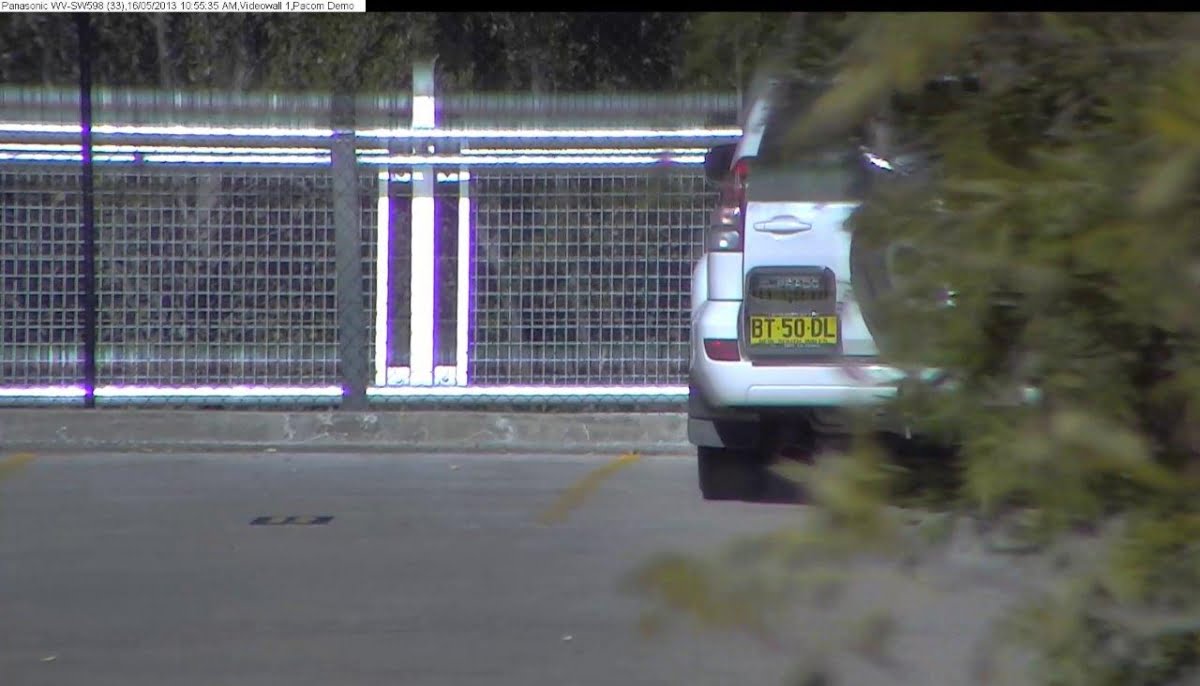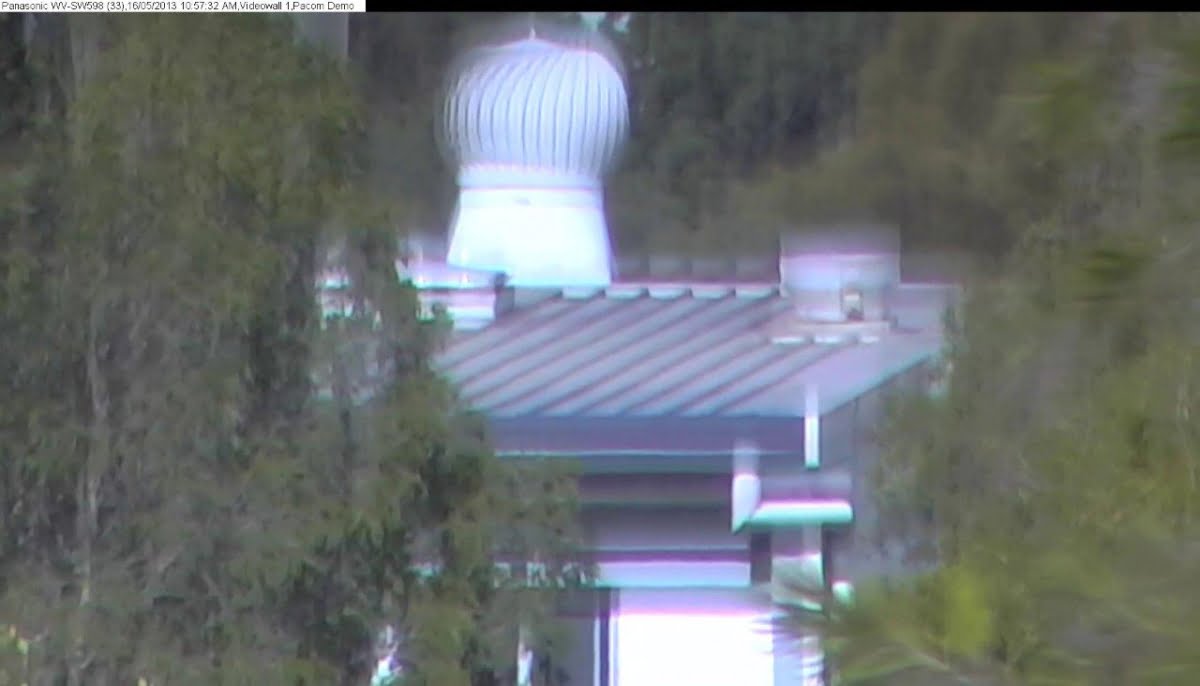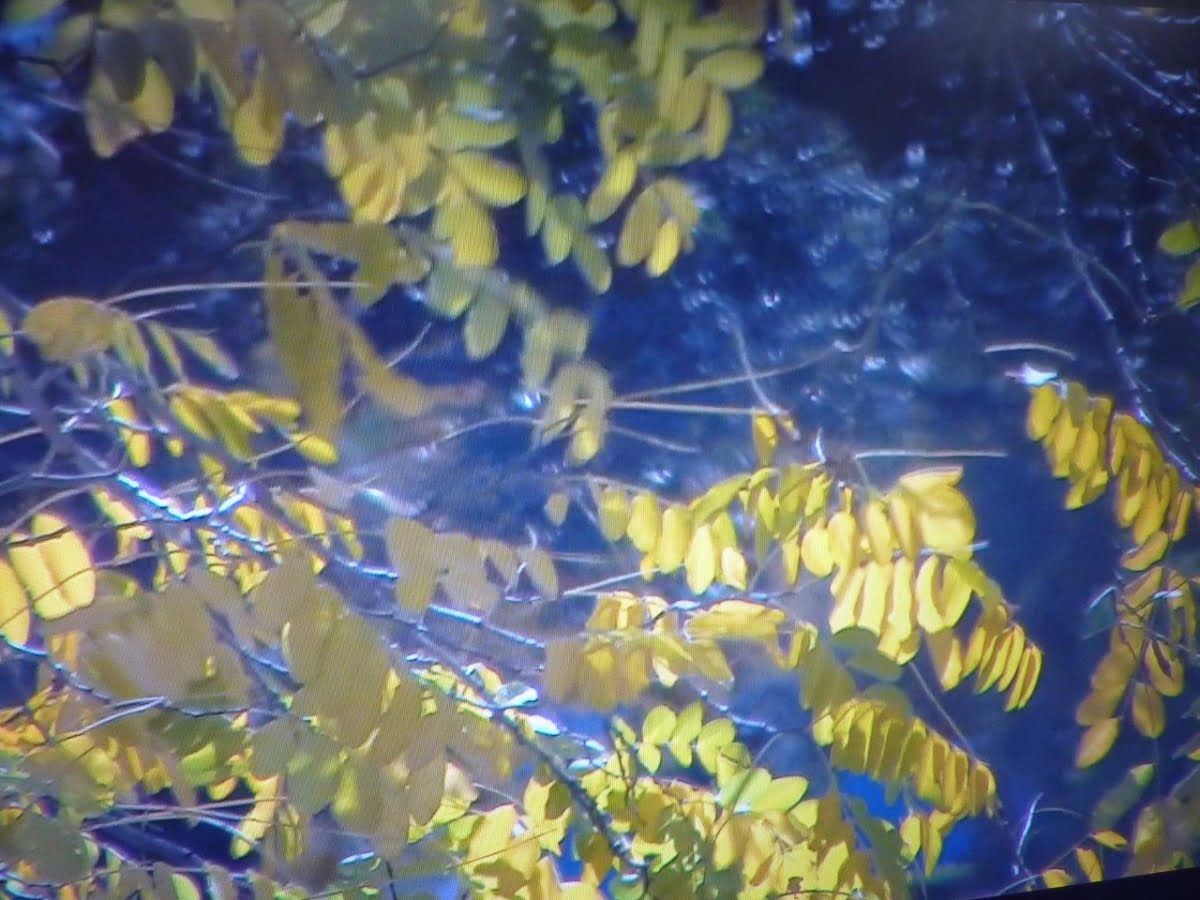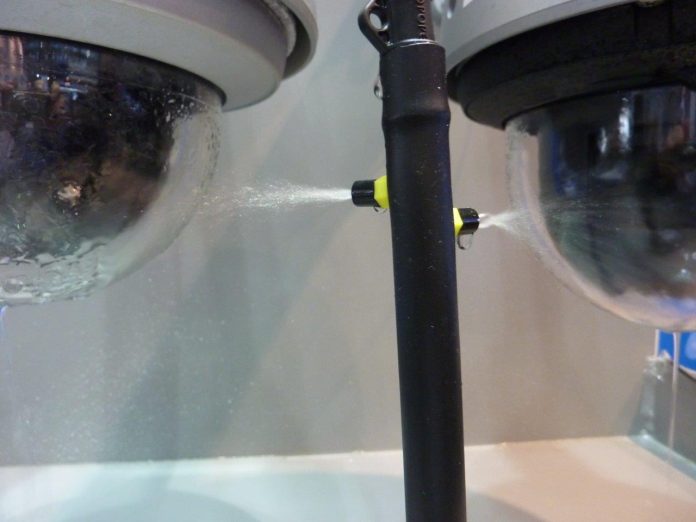PTZ cameras are all the same, you think? Think again. Panasonic’s new baby, the WV-SW598, lifts the bar with a solution that offers powerful new features, along with an outstanding range of core capabilities.
This 1080p HD camera has a 1/2.8-inch progressive scan sensor (2.4MP) and features PoE+, digital noise reduction, video motion detection in 4 areas, 120-degree/ps manual panning, 300 degree/ps panning to 256 presets and a 360-degree map shot.
There’s a browser GUI, audio input/output, 3 alarm source inputs including VMD, command alarm and sound detection. There are also selectable transmission modes including constant bitrate, frame rate priority and best effort advanced VBR. Operating temperature is wide between -50C and +55C.
There’s also an auto tracking function which means that when a motion is detected in a registered monitoring area, the camera will track the motion (object) and capture it. Handling long range vision is 30x optical zoom with 90x digital extra optical zoom.
The camera features Panasonic’s Super Dynamic (WDR), Day/Night capability, and claims 0.5 lux in colour mode and 0.06 in monochrome. The Electronic Sensitivity Enhancement and Day/Night features enhance this capability even further to 0.03 lx(Color)/0.004 lx(BW) when filming in the dark, making these cameras ideal for 24-hour surveillance.
You get VIQS (variable image quality on specified area) and face detection, as well as 32 privacy zone masking and an SDXC memory card slot (up to 2TB) handling edge recording. Other features include very selectable compression, frame rate and bit rate options, support for IPv6, up to 14 simultaneous users and mobile device compatibility including iPad, iPhone, iPod Touch and Android.
Looking after the heavy work are an aluminium housing with an IP66 rating, a dehumidifier and Panasonic’s new hydrophilic Rainwash coating. The camera has a light shielding mechanism called Auto Eye-lid Mechanism (AEM) and fog, smoke and sandstorm compensation. Weight is around 5kg.
Test driving the WV-SW598
I got a test drive of the SW598 at Pacific Communications’ office at Rydalmere with Fraser Larcombe, business development manager – security and products, Panasonic Australia and Pacific Communications’ NSW state manager, Scott Myles.
Larcombe is excited about the camera and wastes no time telling me he thinks this new PTZ from Panasonic is destined to be the one.
“I’m confident this camera will wipe the floor with the competition,” he says. “It’s also going to be cheaper than the competition. I’ve very confident in this camera. I really think our engineers have nailed it with the WV-SW598. Best of all, the engineers are telling me this pre-release unit is not as good as the final version will be.”
When Larcombe points out the salient features, the quality that intrigues me most is Panasonic’s Rainwash coating. It’s claimed to offer self cleaning, as well the mysterious ability to ensure images are not distorted by water droplets forming on the normally hydrophilic (water loving) surface of the camera dome.
“I’ve been showing this around the place and the interest I have got from government is incredible,” Larcombe tells me as we sit down in the Pacific Communications’ control room. “Any large outdoor application – airports, universities, public surveillance – where cameras are installed outside or mounted on poles, Rainwash makes a huge difference.”
We take a look at a couple of images of external cameras not cleaned for 3 months. The Rainwash coating clearly makes a huge difference. How does it work? While the company doesn’t specify this, hydrophilic coatings are made up of a thin film titanian dioxide coating called Titania. The coating is relatively inexpensive, food grade and inert without light.
Titanium dioxide coatings have both a photocatalytic cleaning phase and a superhydrophilic cleaning phase. In the first phase, UV light breaks down dirt on the treated surface. During this process the surface is rendered superhydrophilic through the creation of oxygen vacancies at bridging sites on the treated surface.
In the second stage, raindrops or sprays of water simply get under the dirt and carry it away. Useful too, this process leaves no image distorting streaks or droplets thanks to the fact that the central characteristic of titanium dioxide coatings when they go superhyrodphilic is to spread water evenly across the surfaces to which they are applied.
The coating is long lasting – about 7 years – and it’s not effected by salt – but there are points you installers will have to take into account. You can’t touch the housing with your fingers during installation without messing with its chemical properties. To make life easy there’s a plastic shroud over the dome that’s the last thing you remove.
“I really think our engineers have nailed it with the WV-SW598. Best of all, the engineers are telling me this pre-release unit is not as good as the final version will be”
At this point in our demo, Scott Myles heads out to spray the WV-SW598 installed outside the office with a bottle of water. You can immediately see the water wicking off the housing. Usually there would be significant blurring of the image as droplets run over the housing but in this case there’s none of that whatever.
Image shows photo of monitor screen mid-spray, with accumulating water wicking off. This scene looks to the South – the direction we go digging with the camera’s fabulous zoom.
Trying hard I manage to see some areas with moisture influencing the scene but it’s not easy to spot and as we pan around I can only see it in a backlit image where Larcombe tells me the coating of the demo unit has been touched by wayward hands. We are putting a lot of water on one area of the housing – far more than rainfall could manage – but it clears quickly. The water falls off, it just seems to vanish – spread evenly across the surface by the superhydrophilic process instigated by the UV light.
Something to bear in mind with Rainwash is that it allows maintenance crews to clean dome housings using water jets from the ground – that’s much easier and cheaper than having to get up and squeegee the dome with window cleaner every couple of months.
While we are messing around with Rainwash, I’m paying attention to the scenes in the background, the depth of field, the WDR and the colour rendition and through the splashes of water I suddenly realise this camera’s performance is really good. In fact performance is so exceptional, I change the subject to talk about it.
The WV-SW598 is set at 30ips and we are viewing images on a 1080p HD monitor over a local network via a PoE switch. Ambient light levels to the South are 11.5 EV at 100 ISO (7200 lux). The management system is DVTel Latitude NVMS supported by standard keyboard and mouse.
Remember, zoom is 30x optical supported by 90x extra optical. The 30x optical zoom lens offers display of enlarged image without deterioration of image quality. Supporting this is the extra optical zoom function, which offers up to 90x optical zoom, meaning up to 1080x is available when the optical zoom is used together with digital zoom.
Important to take into account is the fact that the extra optical zoom function is available only when the image capture size setting is set to 640 x 360 pixels. What this means is that when using the digital zoom, image quality drops as zoom increases. (The resolution will automatically change from 1080P once the threshold has been reached, you can see a pause when it hits 90x as it switches over to 640 x 360.
The Pacom office is in an ideal location to challenge the WV-SW598’s native performance and I’m here at the right time of day for the job. Outside it’s full sun and very bright. The big industrial park on South St is deep and the camera is mounted at about 3.5m about half way down the site.
At the south end of the site is the Parramatta River, invisible to us through a welter of mangrove trees, and behind it on the far bank lie the outbuildings of a refinery. The total distance is about 300m and the layers of moving trees on either bank of the river give an idea of clarity, depth of field and motion blur.
We start out looking at number plates down the site towards the river – about 175-200m but this is so easy it’s not long before we start looking for something that will really challenge the WV-SW598. As we peer through the mangroves with Larcombe juggling the controls, we are clearly seeing quite fine detail on refinery buildings at more than 300m.
Number plates at 175-200m – note leaves in mid-ground and on river bank over the fence
The depth of field is surprising as well. PTZs push their depths of field out with optical zoom but I have a sense the useful depth of field of this camera at full zoom is 50-75m. It’s hard to be certain of exact distances but we are definitely seeing individual leaves on our side of the river bank when focused on the far buildings.
Refinery buildings at 300m
Larcombe has the optical zoom at 30x and the extra digital mode is also activated. We spend time at 498x zoom but Larcombe points out that we are down into VGA resolution here. Then we go to 836x zoom. You are still getting detail though the resolution has fallen away significantly at this extreme zoom. The fact it works at all is mind boggling and when I express my admiration for the outstanding performance, Larcombe tells me the unit we are viewing is an engineering sample, not the mass production unit and there’s some firmware enhancement to come.
Next we compare the performance of the WV-SW598 with the WV-SW396E, Panasonic’s hitherto flagship 720p HD PTZ. While the older model is still very capable, you can see the difference in quality instantly. The 720p WV-SW396E with 36x zoom starts swimming at extreme distances while the WV-SW598 is still reaching into the scene and snagging detail.
When we compare the 2 cameras by directly focusing on the refinery building, the superior clarity of the WV-SW598 is very evident. At closer ranges differences in colour rendition, sharpness, resolution and ability to handle motion are clearly visible. The differences in backlight performance are very noticeable, too.
Wide dynamic range
The other impressive characteristic of the WV-SW598 camera is wide dynamic range. It really is outstanding. When we spin the camera away from the refinery we’re looking to the North, into full low, midday winter sun. I climb up the ladder and measure incidental light at the dome as 18 EV at 100 ISO, that’s a blinding 656,000 lux.
Looking into full sun – this is a photo of an HD monitor screen – that’s why you see diagonal lines
In the face of this barrage the colour is excellent and the sharpness is great too. We start by zooming into the leaves of a tree at 17x – and the camera starts showing off. Into full sun, the light is perfect, the edges crisp. As we drive the dome from 20m up to the tall trees on South Street even closer to the sun, at around 200m, performance is remarkably consistent despite the intense light.
The camera dips into shaded areas at the front of the site (towards the sun) and snares license plates with no drama. In my opinion this work is probably the most challenging effort the camera has to make during the demo and it does well. I notice that the quality of the image during pan and zoom are also very impressive, without excessive blur or smearing.
Generally, this is an exceptional picture, the colours are very true, texture of walls, reflections of light, the ability to handle backlight all this is brilliant. The smoothness of the video is also impressive. The movement of clouds, leaves, branches, cars are all well rendered despite 20km or more wind that’s testing many of our zoomed scenes with silly amounts of movement.
This is most apparent when we start looking at license plates. Close up (about 20m) but with loads of reflection (13 EV or 20,480 lux at the plate) the camera is oblivious to punishment. We park a car at the end of the carpark to the south – it’s probably 150-200m away with trees at about 100m to challenge the autofocus. The depth of field performance is outstanding. We get clarity of leaves and license plate. The amount of movement in the scene – probably 25-30 per cent total scene movement – doesn’t phase the camera, either.
When Larcombe digs deep with the digital zoom (400x plus) and we get to VGA with the plate filling the screen there’s a little shake evident in the camera, but this is typical. We then check out a closer license plate looking back into the sun and it’s a great image, too, even at 120x zoom.
Overall, performance is really good. The way the WV-SW598 is handling this group of challenges is exemplary.
It would be nice to see the camera working in low light but that’s not going to happen on this daytime trip. Prior experience suggests the big, unlit industrial site at South St wouldn’t be an accurate reflection of performance in any case. Panasonic quotes 0.5 lux in colour and 0.03 lux in monochrome and the company tends to be very accurate with its claims.
Looking North towards the sun – again this is a photo of a screen, not a screen grab
Feature creature
Usually in a review like this the story would end here but that’s not the case with the new Panasonic PTZ thanks to a number of other features that deserve special attention. The first of these is light shielding and it’s another first for Panasonic and for the electronic security industry.
“The majority of PTZs at the tilt of zero will almost give you a double image because of the reflection of light from the dome into the lens,” Larcombe tells me.
“Panasonic’s light shielding mechanism is a physical shield that swings down at 0 degrees to block reflection and ensure a clear image. We’ve also got rid of the boundary line at 0 degrees.”
Larcombe rolls up the camera tilt and the first time I don’t catch the ASA resin light shield in action but if you concentrate without focusing on one spot you can actually see the shield moving into place. It’s not a slow movement, you catch it as if from the corner of your eye – nothing that would trouble an operator or get in the way of action in a busy scene. And it works. Evidence of double image at 0 degrees? Zero.
The next feature we check out is Face Detection with Super Dynamic, which detects human faces in a scene and makes them easy to identify. This feature works really well with backlight and deeper fields of view. The demo we view shows a person walking to a door with a large window and a deep scene behind. The camera adjusts as the person walks into the scene so as to ensure the face is recognisable. This is harder than it looks in a backlit scene with a moving face.
Watching the camera juggling this process in real time is interesting. I expected face recognition would come at the expense of clarity and compromise in depth of field and backlight performance at the sides of the scene but this did not seem to be the case.
Another feature we check out during the demo on still is the Fog and Smoke reduction. The performance is very impressive. This is great for airports, ports and large open scenes. We view harbour scenes with fog/smog and this feature makes a real difference. I could imagine it would be useful for peering through firework or flare smoke at stadiums, too.
Another useful feature is VIQS (variable image quality on specified area) which allows high resolution in areas of the image that are of importance, while areas of no importance like sky, a roof or an upper wall, can be recorded at lower resolutions.
Two areas (total of up to 40 per cent of the overall image) can be indicated as high-resolution monitoring sections. Larcombe tweaks this feature and shows me that the typical saving is around 25 per cent – a significant amount. The single 1080p, 30ips image stream we are viewing is 464kbps without the VIQS activated. With VIQS on, the stream drops to 299kbps.
“Other camera brands say they offer low compression but I’ve not seen one that comes close to us and with VQIS activated, no one is anywhere near us,” Larcombe assures me.
Next comes edge storage which includes features like local recording by camera, manual schedule and alarm trigger, data recovery for FTP transmission and data recovery for network recorder. According to Larcombe, this last is written into leading VMS solutions.
“Basically what happens is that when the camera realises there’s no VMS to record to it will switch over to the onboard SD card and we’re working with the VMS manufacturers so that when that happens, after recovery systems can seamlessly retrieve images from those edge locations,” he explains.
Both Larcombe and Myles are pleased as punch with the WV-SW598 and having sat through a lengthy demo with the boys, I can see why. It’s been a while since a PTZ really made me sit up and take notice but this one did.
Sure, there are some nice new features here – Rainwash and Lightshield foremost among them – but it was the fundamental performance parameters that really shone through.
Given this is not an objective comparison of leading brands, it’s a subjective assertion to suggest the WV-SW598 is now the benchmark in 1080p HD PTZs. But it’s an assertion I’m comfortable making.
Features of the Panasonic WV-SW598 include:
* 30x Optical Zoom, 90x Ex Optical Zoom
* High Resolution(1080p Full HD images up to 30fps)
* Face Detection with Super Dynamic Technology
* Fog and Smoke Reduction
* 2-area VIQS (Variable Image Quality on Specified Area)
* SDXC Memory card edge recording
* Smartphone, Tablet PC monitoring
* Rain-wash coating
* IP66 with dehumidifier
* Wide ambient operating temperature
* Vandal resistant mechanism.
By John Adams













